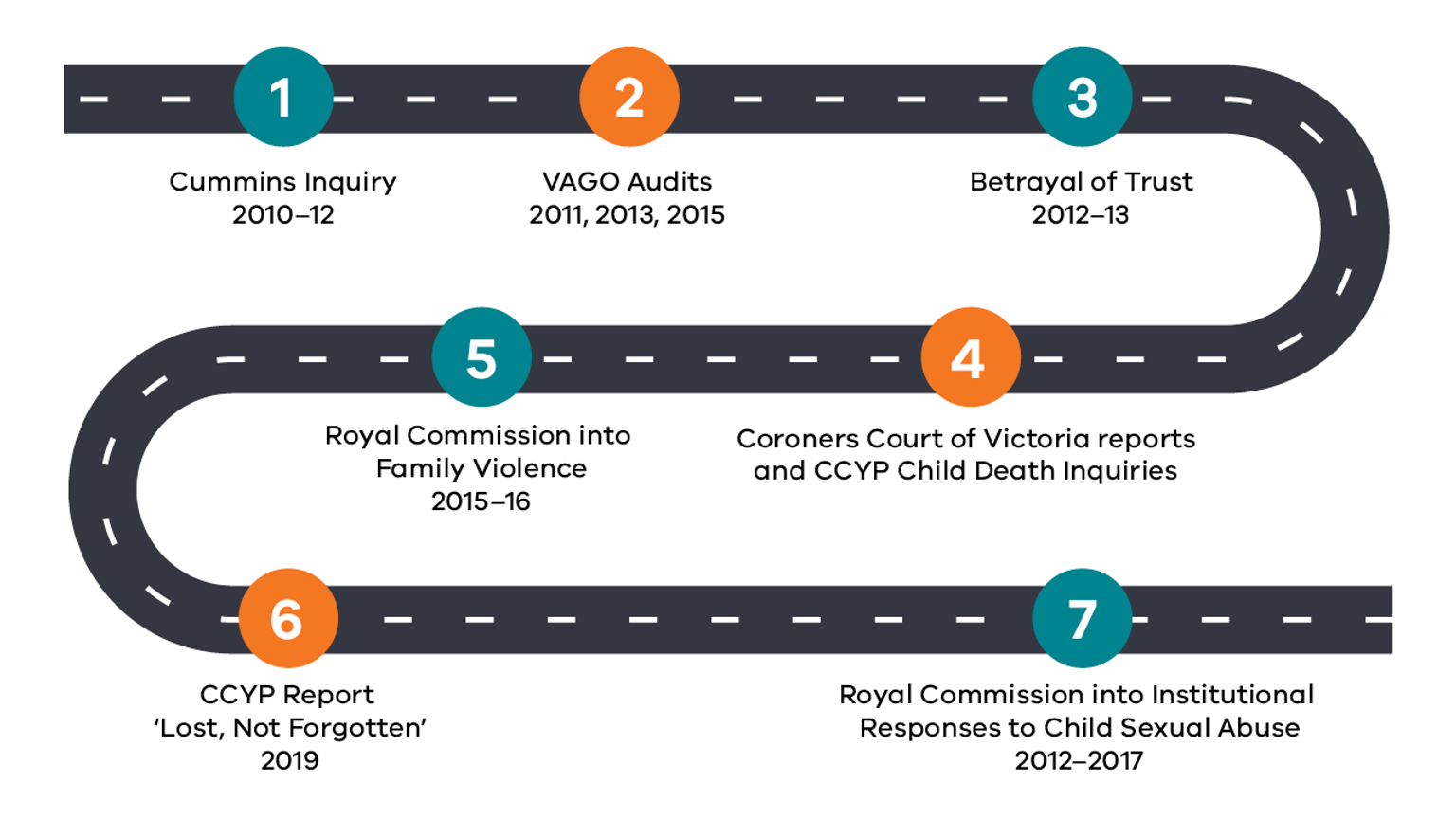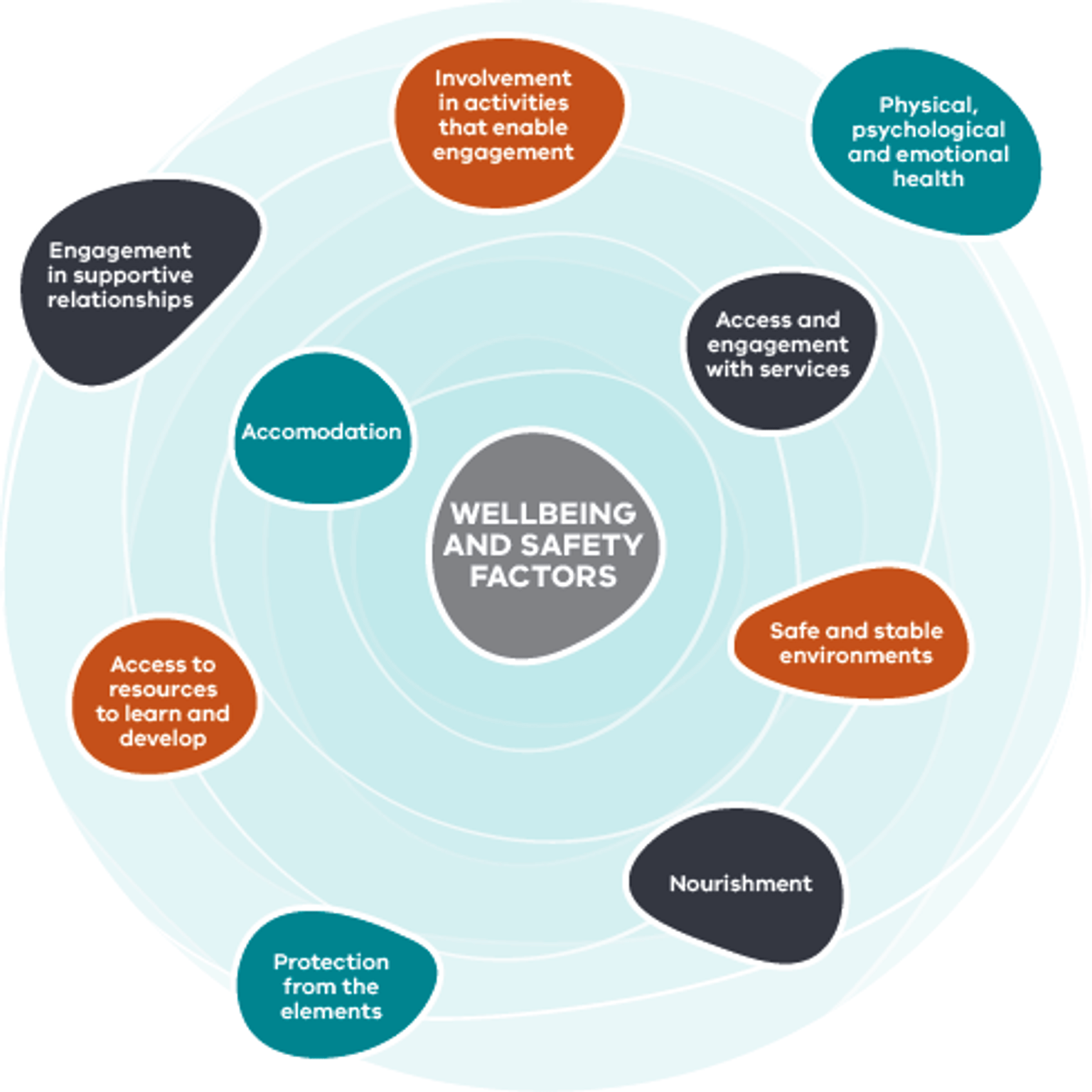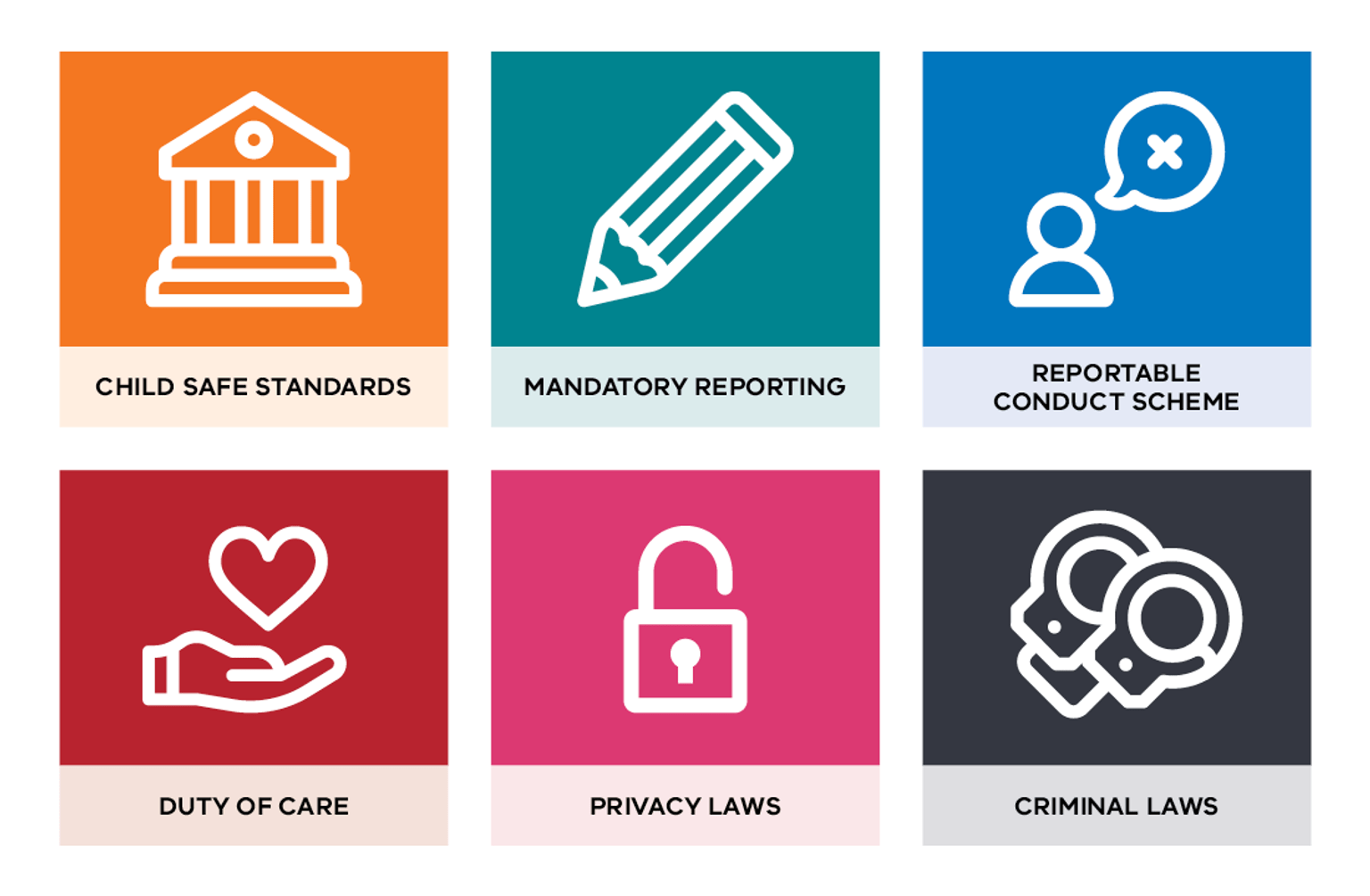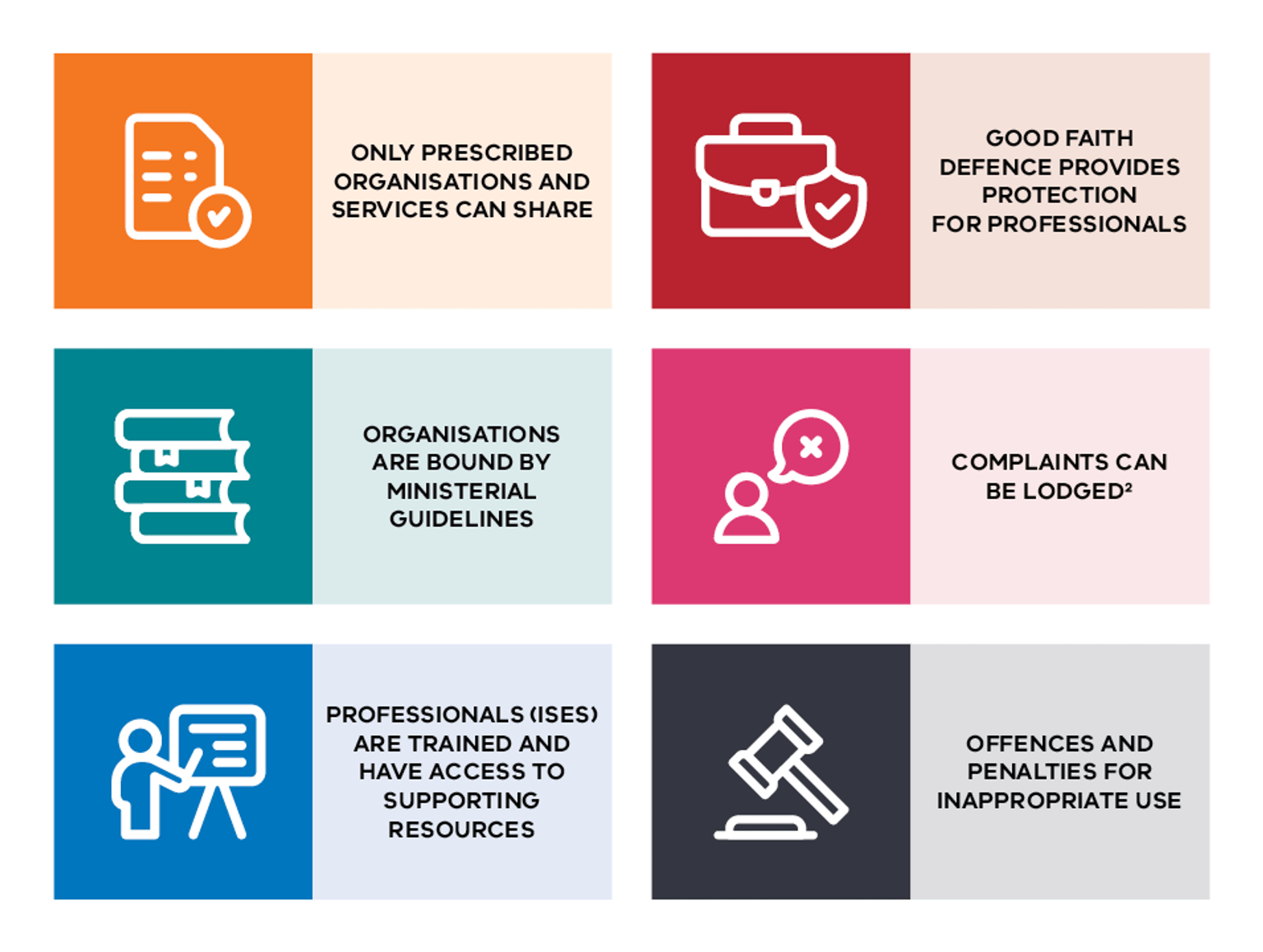About this resource
This resource is intended to support schools and services, system and statutory bodies, and education health, wellbeing, and inclusion workforces to:
- implement the Child Information Sharing Scheme (CISS) and Family Violence Information Sharing Scheme (FVISS) in their workplaces
- share information confidently, safely, and appropriately to improve children’s and families’ wellbeing and safety, and manage family violence risk
- meet their responsibilities under the Family Violence Multi-Agency Risk Assessment and Management Framework (MARAM)
- identify and respond to family violence in a safe and consistent way and make better reports and referrals.
CISS, FVISS and MARAM are collectively known as the Reforms in this resource. This resource is for:
- long day care, kindergarten and before and after school hours care services (referred to as services in this resource)
- government, Catholic and independent schools (referred to as schools in this resource)
- Catholic and independent system bodies that assist, manage, or govern schools in Victoria (referred to as system bodies in this resource)
- Victorian Institute of Teaching, Victorian Curriculum and Assessment Authority, and Victorian Registration and Qualifications Authority (referred to as statutory bodies in this resource)
- some education health, wellbeing, and inclusion workforces (for example, Department of Education’s Health, Wellbeing, and Inclusion Workforces).
This resource is divided into 4 audience-based sections:
- Introduction
- School and service leaders
- All staff
- Staff who use CISS and FVISS
- MARAM nominated staff.
It also includes the following resources:
- Tools
- Staff supports and other resources.
How to use this resource
Each section of this resource provides tailored guidance to reflect the different roles and responsibilities of staff at your school or service. You may need to read one or more sections depending on your role.
You can download all tools and templates from this publication.
All schools and services must ensure all tools and templates are stored in a secure location that can only be accessed by relevant staff, such as school and service leaders, MARAM nominated staff and authorised staff.
You must also follow all data security and record management requirements that apply to your school or service. For more information, please see How do I keep records? in the MARAM nominated staff section.
Training and support
The Department of Education (the department) offers a range of learning options on the Reforms for schools and services, system and statutory bodies, and education health, wellbeing, and inclusion workforces. This includes webinars, eLearning modules and face-to-face training.
For more information see Training for the information sharing and MARAM reforms.
If you have any further questions about CISS, FVISS and MARAM, or this resource, including support with implementation, contact the Enquiry Line:
- Email: cisandfvis@education.vic.gov.au
- Phone: 1800 549 646 from 9 am to 5 pm Monday to Friday.
Staff wellbeing support
Supporting children and families who are experiencing wellbeing and safety concerns, including family violence, can be highly stressful and challenging. Given the reported prevalence of family violence, there is also a high likelihood you may know or be someone who has experienced or is experiencing family violence.
Staff wellbeing is a shared responsibility between you, your team and your organisation.
It is important to be aware of the impacts that supporting people experiencing family violence can have on you. Signs of vicarious trauma and burnout include experiencing intrusive thoughts of a victim survivor’s situation or taking on too great a sense of responsibility. These are common responses to the challenges of this type of work.
This resource addresses issues of family violence. If you are concerned for your safety or that of someone else, contact the police, and call 000 for emergency assistance.
If you have experienced violence or sexual assault and require immediate or ongoing assistance, contact 1800 RESPECT (1800 737 732) to talk to a counsellor from the National Sexual Assault and Domestic Violence hotline. For confidential support and information, contact Safe Steps 24/7 family violence response line on 1800 015 188.
If you need to talk to someone it is recommended that you speak to your leadership team about arranging appropriate support. You can also talk to your GP or an allied health professional. Victorian government school staff can also contact the Department of Education’s Employee Wellbeing Support Services on 1300 291 071.
For more information, see Staff supports and other resources.
Overview of the Information Sharing and Family Violence Reforms
As educators, carers and health, wellbeing, and inclusion professionals, you share a common purpose – to give each child the best start to a happy, healthy, and prosperous life. The wellbeing and safety of children is essential for their learning and development, and you are well placed to support them.
CISS, FVISS and MARAM (the Reforms) build on and complement your existing child and family wellbeing and safety responsibilities and practices. The Reforms aim to improve the wellbeing and safety of Victorian children, and to reduce family violence.
The Reforms enable Information Sharing Entities (ISEs) to request and share relevant information with one another to support child wellbeing and safety and assess or manage family violence risk. Information sharing and service collaboration are vital in identifying risks early and facilitating early and appropriately targeted support. Numerous Royal Commissions, coronial inquests and independent inquiries over a decade have made this clear.
The Reforms authorise schools and services, system and statutory bodies, and education health, wellbeing and inclusion workforces to:
- respond to requests for information to promote child wellbeing or safety, and/or assess and manage risk of family violence (this is mandatory)
- request information to promote child wellbeing or safety and/or manage risk of family violence
- proactively share information to promote child wellbeing or safety and/or manage risk of family violence.
The Reforms have been designed to promote the wellbeing and safety of children and families by:
- improving earlier identification of issues or risks, including family violence risk, and enabling earlier support and participation in services
- increasing collaboration and supporting a more coordinated and integrated approach to service delivery across the service system
- empowering professionals to make informed decisions
- promoting shared responsibility for wellbeing and safety, and defining responsibilities for identifying and responding to family violence across the service system, including creating consistent and collaborative practice
- identifying wellbeing and safety issues and risks, and obtaining relevant information to share in relation to family violence (by applying MARAM guidance on what to look for and what questions to ask).
CISS enables ISEs to share relevant information about any person to promote the wellbeing or safety of a child or group of children.
Consent is not required from any person when sharing under CISS.
FVISS enables ISEs to share relevant information to assess or manage risk of family violence.
It is best practice to seek and consider the views and wishes of victim survivors when sharing their information (if safe, reasonable, and appropriate to do so). However, under FVISS consent is only required from an adult victim survivor or third party where no children are involved and there is no serious threat to an individual’s life, health, safety, or welfare.
Schools and services, system and statutory bodies, and education health, wellbeing and inclusion workforces have expanded permissions as ISEs to share information for wellbeing and safety. While the ISEs prescribed under CISS and FVISS are broadly similar, some services and organisations are prescribed under one scheme and not the other.
What is an ISE?
An ISE, or Information Sharing Entity, is an organisation or service that has been prescribed in legislation to request and share information under the Reforms.
ISEs include services that work with children, young people and families, such as:
- schools
- kindergartens
- long day care
- out of school hours care (OSHC)
- Child Protection
- youth justice
- Maternal and Child Health
- public hospitals
- Victoria Police.
For more information on the workforces prescribed as ISEs under CISS and FVISS, see Who can share information under the information sharing and MARAM reforms. You can also search for details of the organisations that are prescribed as ISEs at the ISE List.
MARAM aims to build a shared understanding of family violence across Victoria’s service system. MARAM is embedded in law and establishes the foundations for a consistent statewide approach and shared responsibility for identifying and responding to family violence.
Schools and services are prescribed as MARAM Framework organisations and are required to follow MARAM when identifying and responding to family violence. Key services such as Victoria Police, family violence specialist services, Child Protection and hospitals across Victoria are also prescribed MARAM organisations. This means that everyone in the service system has the same understanding of family violence and can respond in the same way. This ensures people get the help they need and stops them from falling through any cracks in the system.
For a list of prescribed MARAM framework organisations, see Appendix 1: Prescribed organisations.
For more information about MARAM, see Information Sharing and MARAM reforms.
Wellbeing and safety for all Victorian children
There are many factors that impact a child’s wellbeing. Parental, family, and community wellbeing, as well as cultural context and intersectional identity, all have a significant impact on a child’s wellbeing. ‘Intersectionality’ refers to the ways in which different aspects of a person’s identity can expose them to overlapping forms of discrimination and marginalisation.
When these aspects or characteristics combine:
- there is a greater risk of people experiencing family violence
- people find it harder to get the help they need due to systemic barriers
- there is increased risk of social isolation.
You should reflect on your own practice and biases to ensure you can demonstrate an understanding of how this may be experienced by Aboriginal people or people from diverse communities or at-risk age groups. Where improvements can be made, you should tailor your approach accordingly to allow access to resources and support and services to respond to family violence risk.
It is important to have a shared understanding of the protective factors for children, such as engagement in education and safe housing, as well as the factors that contribute to the wellbeing and safety of the children and families in your care. You are encouraged to use your professional judgement and build and strengthen your current practice, informed by your organisation’s existing wellbeing frameworks.
There may be instances where information needs to be shared to promote the wellbeing or safety of more than one child, including cases where one child poses a risk to another. In such cases, professionals should exercise their judgement to consider and balance each child’s wellbeing and safety to achieve the best possible outcomes for each child.
You can and should also connect with other ISEs to gather or share relevant information, and to coordinate actions to support children’s wellbeing and safety.
For more information, see Understanding child wellbeing.
Cultural safety
Aboriginal peoples and families are extremely diverse in terms of their structure and dynamics. This diversity includes the concept of family, which can be much broader than for non-Aboriginal people, encompassing kinship relationships and the broader Aboriginal community. Whatever form they take, strong families are pivotal to the health and wellbeing of Indigenous communities.
In addition to the wellbeing factors listed in Figure 2, there are a range of cultural and spiritual factors that contribute to an Aboriginal person’s wellbeing.
The wellbeing of Aboriginal peoples occurs in the context of colonisation, dispossession, and the loss of culture. This has contributed to the breakdown of kinship systems and traditional law.
To redress personal and systemic biases, all workforces engaged in risk assessment and management should participate in ongoing cultural awareness, trauma-informed practice and family violence training.
Organisations and services should promote cultural safety and recognise the cultural rights, kin and community connections of children from Aboriginal and diverse communities. They should actively value and respect a child’s identity as a core aspect of their wellbeing and safety.
The department has developed resources to help schools, services and other organisations discuss the information sharing reforms with Aboriginal families. You can view them at Child Information Sharing – caring for all Koorie children in Victoria.
Child Information Sharing Scheme Ministerial Guidance on cultural safety
When sharing information under the Child Information Sharing Scheme, legislative principles 4 and 5 require information sharing entities to:
“4. Be respectful of and have regard to a child’s social, individual, and cultural identity, the child’s strengths and abilities and any vulnerability relevant to the child’s safety or wellbeing.
5. Promote a child’s cultural safety and recognise the cultural rights and familial and community connections of children who are Aboriginal, Torres Strait Islander or both.”
For the full list of legislative principles, see the Child Information Sharing Scheme Ministerial Guidelines – Introduction.
Family Violence
The Family Violence Protection Act 2008 (Vic) defines family violence as behaviour that:
- is physically, sexually, emotionally, psychologically, or economically abusive
- is threatening or coercive
- is controlling or dominating
- causes fear for the safety or wellbeing of that family member or another person
- causes a child to hear, witness or otherwise be exposed to the effects of any behaviour referred to above.
Family violence is deeply gendered. While people of any gender can be perpetrators or victim survivors of family violence, overwhelmingly the perpetrators are men, who largely perpetrate violence against women (who are their current or former partner) and children.
Addressing family violence requires a whole-of-community response and a coordinated system working together to support adult and child victim survivors, address risk and safety needs, and promote perpetrator accountability.
“The significant majority of perpetrators are men and the significant majority of victims are women and their children.”
Working collaboratively to support wellbeing and safety
Family violence and diverse communities and at-risk groups
The Royal Commission into Family Violence found that for diverse communities and at-risk groups, family violence is less visible and understood than for other parts of the Australian community. Many also face additional barriers to reporting, as well as seeking and obtaining the help they need to be safe and recover from violence due to structural inequality and discrimination based on background, identity, and culture1.
While there can be similar dynamics to family violence across all communities, people from Aboriginal and diverse communities may also experience family violence differently. They may face barriers to reporting and finding appropriate responses and support. Barriers may result from:
- language
- visa status
- experiences of discrimination
- historic and ongoing systemic oppression
- fear of reprisals or exclusion or isolation
- concerns about their safety.
The level of risk for family violence can also change over time. For example, women are at greater risk of family violence during pregnancy or after separation from their partners.
These dynamics mean that there are additional considerations when sharing information about diverse communities and at-risk groups. Professionals are advised to seek guidance and support, including from specialist services, as needed.
For more information, see:
- Child Safe Standard 5: diversity and equity
- Child Safe Standard 1: culturally safe environments for Aboriginal children
“When services do not share information, they do not have all the necessary background to make a robust assessment that considers all the risks to a child ... when services do not meet and plan interventions, their responses can be uncoordinated and less effective.”
Commission for Children and Young People Annual report 2016–17
Existing child wellbeing and safety obligations
Existing child wellbeing and safety obligations continue to apply.
The Reforms expand circumstances in which confidential information (including personal, health and sensitive information) can be shared between prescribed professionals. The Reforms complement these obligations and work alongside them to support a more complete system of support for the wellbeing and safety of children.
Safeguards for the Reforms
A range of safeguards and protections exist under the Reforms to ensure that professionals can safely, confidently and appropriately share information.
The good faith defence
A person who is authorised to share information under CISS and FVISS, who acts in good faith and with reasonable care when sharing information, will not be held liable for any criminal, civil or disciplinary action for providing information.
They are not considered to have breached any code of conduct or professional ethics or to have departed from any accepted standards of professional conduct.
Further reading
This resource complements training and should be read in conjunction with the Child Information Sharing Scheme Ministerial Guidelines, Family Violence Information Sharing Guidelines and MARAM Framework, as well as other resources relevant to CISS, FVISS and MARAM.
- Child Information Sharing Scheme Ministerial Guidelines
- Family Violence Information Sharing Guidelines (Go to 'Familiarise yourself with the Ministerial Guidelines')
- Family Violence Multi-Agency Risk Assessment and Management Framework (MARAM)
- MARAM Foundation Knowledge Guide and MARAM practice guides and resources
- Information Sharing Entity list search (ISE List)
Footnotes
- Everybody Matters – Inclusion and Equity Statement – Victorian Government 2018.
- See Complaints in the Staff who Use CISS and FVISS section.
Updated



